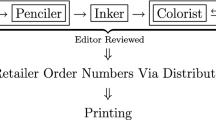Abstract
This study considers the Australian DVD industry using a data set of retail sales for over 44,800 titles 1997–2007. A sub-sample of 760 titles which also received an initial theatrical release reveals that the DVD revenue distribution has thicker tails than the theatrical revenue distribution implying the top-ranked DVDs earning a greater share of revenues than their theatrical contemporaries. A comparison of revenues finds not only a high degree of correlation between the two markets, but a relationship that is nonlinear and increasing at higher theatrical revenue levels. This finding is consistent with a word-of-mouth momentum effect and more institutional flexibility in the DVD market. The high levels of correlation are present across all genres/ratings and are observed to be stronger for large release titles. Finally, a seemingly unrelated regression structure is proposed to jointly consider the two markets, which is shown to be empirically valid.



Similar content being viewed by others
Notes
For example, the US Consumer Electronics Association estimate sales of digital direct-view TV receivers, HDTV, flat panel, projection TV and combination TVs increased sales from 5.5 million units in 2003 to 27.1 million units in 2007.
Australian Film Commission (AFC) (2008).
In Australia, companies such as HMV, JB Hi-Fi, Sanity, and Harvey Norman are examples.
See De Vany and Walls (1996).
The 13-week data set means there is no bias from different survival times as all titles observed for the same length of time. Also, there is no truncation of revenues due to a ‘chart exit’ effect, meaning all revenues are observed for the full 13 weeks.
Australian Visual Software Distributors Association (AVSDA) (2007).
AFC 2008.
GfK Marketing Services (2008).
Motion Pictures Distributors Association of Australia (MPDAA) (2008).
GfK, cited in AFC (2008).
AFC (2008).
Trade Services of Australia Video Source 2007, cited in AFC (2008).
AFC (2008).
Sales of DVDs in sell-through retail exceeded $1bn in 2004 (AVSDA 2008).
The raw data also reports an 8 week sales figure. As an average, 8 week sales comprise 81% of the 13 week revenue figure.
See Nelson et al. (2008) for an empirical analysis of the ‘out-of-market’ (release) gap for films released in the US market from 1998 to 2005.
Placing several films in the population is the initialisation for the model, however, Ijiri and Simon (1964) show that after large t, the resulting distribution is insensitive to the number of firms (films) chosen.
Ijiri and Simon (1964) show, by simulation, that the firm size distribution exhibits downward concavity if δ < 1, is a straight line if δ = 1, and has downward convexity if δ > 1. The curvature is greater as |δ − 1| is greater. The parameter δ has a simple economic interpretation and describes the relative significance of recent sales, as compared with earlier sales, in generating future sales. Both recent and prior sales contribute to future sales but the latter contributes less than the former if δ < 1 and vice versa. This is shown analytically in their (1974) paper for the case where 0 < δ < 1 (distribution concave downward).
Ijiri and Simon (1964) show in their simulation that a slight deviation of δ = 0.95 was sufficient to create considerable curvature for the distribution.
De Vany and Lee (2001) describe a simulation model in which agents relate quality information about films which they have seen. They show that the resulting statistical distribution is Pareto-Levy stable which is consistent with box office revenues observed empirically.
Other closely related distributions include the Generalised Pareto, Generalised Extreme Value, Weibull, etc.
Owing to the empirical density not exactly fitting the theoretical Pareto distribution in the upper tail, the estimate of α is necessarily sensitive to the size of the tail chosen. In saying this, however, regardless of the tail size chosen, estimated α is consistently less in the DVD sample consistent with the assertion that there is more probability mass in the distribution of DVD revenues than theatrical revenues.
A simple regression of DVD sales on theatrical box office with a quadratic term yields \( {\text{DVD}}\,{\text{revenue}} = \begin{array}{*{20}c} { - 14785.12} & + & {0.1112\,{\text{theatrical}}\,{\text{revenue}}} & + & {3.49{\text{e}}-09\left( {{\text{theatrical}}\,{\text{revenue}}} \right)^{2} } \\ {\left( { - 0.45} \right)} & {} & {\left( {14.03} \right)} & {} & {\left( {15.18} \right)} \\ \end{array} \) where t-values are in parentheses. Note N = 760, R 2 = 0.8301.
An alternative to this ‘approximation’ approach might be to transform the left hand side variable into a binary variable as done by De Vany and Walls (1999) and Collins et al. (2002), however, this approach necessarily entails loss of information in this transformation. Walls (2005a, b) has employed various remedial regression structures which explicitly account for skewness and heavy tails such as the skew-normal, skew-t and symmetric stable model, but often these remedial techniques come at high computational cost and would be econometrically intractable in a simultaneous regression structure.
Formally, this statistic is given by \( \lambda = T\sum\nolimits_{s = 1}^{S} {\sum\nolimits_{r = 1}^{s - 1} {r_{sr}^{2} } } \), where r sr is the estimated correlation between the residuals of S equations, and T is the number of observations. Since S = 2 in this model, the statistic becomes λ = Tr 2 which is distributed χ 2 with 1 degree of freedom.
Moul (2007) uses the serial-correlation in the error term as a measure of this word-of-mouth effect using a sample of weekly revenues in a nested logit model of demand.
It is worth noting that the SUR structure doesn’t change the individual parameter estimates themselves but does change the standard errors associated with these estimates.
References
Anderson, C. (2006). The long tail: Why the future of business is selling less of more. New York: Hyperion.
Australian Film Commission (AFC). Various publications. www.afc.gov.au.
Australian Visual Software Distributors Association (AVSDA). Various publications. www.avsda.com.au.
Carlton, D., & Chevalier, J. (2001). Free riding and sales strategies for the Internet. Journal of Industrial Economics, 49(4), 441–461.
Collins, A., Hand, C., & Snell, M. (2002). What makes a blockbuster? Economic analysis of film success in the U.K. Managerial and Decision Economics, 23(6), 343–354.
De Vany, A. (2004). Hollywood economics: How extreme uncertainty shapes the film industry. London: Routledge.
De Vany, A., & Lee, C. (2001). Quality signals in information cascades and the dynamics of the distribution of motion picture box office revenues. Journal of Economic Dynamics and Control, 25(3–4), 593–614.
De Vany, A., & Walls, D. (1996). Bose–Einstein dynamics and adaptive contracting in the motion picture industry. The Economic Journal, 106, 1493–1514.
De Vany, A., & Walls, D. (1999). Uncertainty in the movie industry: Does star power reduce the terror of the box office? Journal of Cultural Economics, 23, 285–318.
De Vany, A., & Walls, D. (2004). Motion picture profit, the stable Paretian hypothesis and the curse of the superstar. Journal of Economic Dynamics and Control, 28(6), 1035–1057.
Dranove, D., & Gandal, N. (2003). The DVD-vs.-DIVX standard war: Empirical evidence of network effects and pre-announcement effects. Journal of Economics and Management Strategy, 12(3), 363–386.
DuMouchel, W. (1983). Estimating the stable index α in order to measure tail thickness: A critique. The Annals of Statistics, 11, 1019–1031.
Einav, L. (2007). Seasonality in the U.S. motion picture industry. Rand Journal of Economics, 38(1), 127–145.
Elberse, A., & Eliashberg, J. (2003). Demand and supply dynamics for sequentially released products in international markets: The case of motion pictures. Marketing Science, 22(3), 329–354.
Elberse, A., & Olberholzer-Gee, F. (2008). Superstars and underdogs: An examination of the long-tail phenomenon in video sales. Working paper no. 07-015. Harvard Business School.
Eliashberg, J., Elberse, A., & Leenders, M. (2006). The motion picture industry: Critical issues in practice, current research, and new research directions. Marketing Science, 25(6), 638–661.
Frank, B. (1994). Optimal timing of movie releases in ancillary markets: The case of video releases. Journal of Cultural Economics, 18, 125–133.
Frank, R., & Cook, P. (2005). The winner-take-all society. New York: The Free Press.
Gemser, G., Van Oostrum, M., & Leenders, M. (2007). The impact of film reviews on the box office performance of art house versus mainstream motion pictures. Journal of Cultural Economics, 31, 43–63.
Hand, C. (2001). Increasing returns to information: Further evidence from the UK film market. Applied Economics Letters, 8, 19–421.
Ijiri, Y., & Simon, H. (1964). Business firm growth and size. American Economic Review, 54(March), 77–89.
Ijiri, Y., & Simon, H. (1974). Interpretations of departures from the Pareto curve firm-size distributions. Journal of Political Economy, 82(2), 315–332.
Jansen, C. (2005). The performance of german motion pictures, profits and subsidies: Some empirical evidence. Journal of Cultural Economics, 29(3), 191–212.
Jozefowicz, J., Kelley, J., & Brewer, S. (2008). New release: An empirical analysis of VHS/DVD rental success. Atlantic Economic Journal, 36(2), 129–151.
McKenzie, J. (2008). Bayesian information transmission and stable distributions: Motion picture revenues at the Australian box office. Economic Record, 84(266), 338–353.
McKenzie, J. (2010). The economics of movies: A literature survey. Journal of Economic Surveys (forthcoming).
Mortimer, J. (2007). Price discrimination, copyright law, and technological innovation: Evidence from the introduction of DVDs. Quarterly Journal of Economics, 122(3), 1307–1350.
Motion Picture Distributors Association of Australia. (MPDAA). (2008). Various publications. www.mpdaa.org.au.
Moul, C. (2007). Measuring word of mouth’s impact on theatrical movie admissions. Journal of Economics & Management Strategy, 16(4), 859–892.
Nelson, R. A., Reid, C. E., & Gilmore, O. (2008). An analysis of the out-of-market gap for DVDs in the U.S. Review of Industrial Organization, 30, 303–323.
Prag, J., & Casavant, J. (1994). An empirical study of the determinants of revenue and marketing expenditures in the motion picture industry. Journal of Cultural Economics, 18(3), 217–235.
Ravid, S. A. (1999). Information, blockbusters and stars: A study of the film industry. Journal of Business, 72(4), 463–492.
Ravid, S. A., Wald, J., & Basuroy, S. (2006). Distributors and film critics: Does it take two to tango? Journal of Cultural Economics, 30, 201–218.
Rosen, S. (1981). The economics of superstars. American Economic Review, 71(5), 845–858.
Shapiro, S., & Francia, R. (1972). An approximate analysis of variance test for normality. Journal of the American Statistical Association, 67, 215–216.
Vining, D. R., Jr. (1976). Autocorrelated growth rates and the Pareto law: A further analysis. Journal of Political Economy, 84(2), 369–380.
Walls, D. (1997). Increasing returns to information: Evidence from the Hong Kong movie market. Applied Economics Letters, 4(5), 187–190.
Walls, W. D. (2005a). Modeling movie success when ‘nobody knows anything’: Conditional stable distributional analysis of film returns. Journal of Cultural Economics, 29(3), 177–190.
Walls, D. (2005b). Modelling heavy tails and skewness in film returns. Applied Financial Economics, 15(17), 1181–1188.
Walls, W. D. (2010). Superstars and heavy tails in pre-recorded entertainment: Empirical analysis of the market for DVDs. Journal of Cultural Economics (forthcoming).
Xing, X. (2008). Does price converge on the Internet? Evidence from the on-line DVD market. Applied Economics Letters, 15(1), 11–14.
Zellner, A. (1962). An efficient method of estimating seemingly unrelated regressions and tests for aggregation bias. Journal of the American Statistical Association, 57, 348–368.
Acknowledgments
I acknowledge the Motion Picture Distributor Association of Australia (MPDAA) and GfK Marketing Services for supplying data used in this study. I also acknowledge support of the Centre for Screen Business (CSB). I am grateful for the suggestions of two anonymous referees. All remaining errors are my own.
Author information
Authors and Affiliations
Corresponding author
Rights and permissions
About this article
Cite this article
McKenzie, J. How do theatrical box office revenues affect DVD retail sales? Australian empirical evidence. J Cult Econ 34, 159–179 (2010). https://doi.org/10.1007/s10824-010-9119-x
Received:
Accepted:
Published:
Issue Date:
DOI: https://doi.org/10.1007/s10824-010-9119-x




